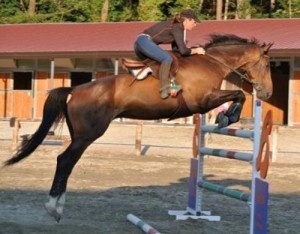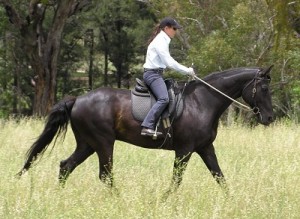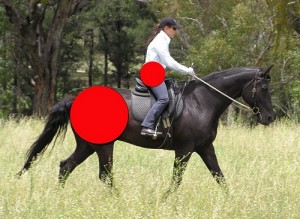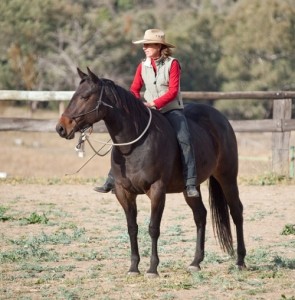 Centring or centering however you choose to spell it, is the most important thing that I could ever teach anyone about horsemanship. If you have been to any of my clinics you will have heard me talk about it time and time again. Teaching centring is usually the first concept I teach in all my introductory clinics and something that we need to take with us and consciously apply throughout all the rest of our horsemanship activities and in fact it will be extremely helpful in every other facet of our lives.
Centring or centering however you choose to spell it, is the most important thing that I could ever teach anyone about horsemanship. If you have been to any of my clinics you will have heard me talk about it time and time again. Teaching centring is usually the first concept I teach in all my introductory clinics and something that we need to take with us and consciously apply throughout all the rest of our horsemanship activities and in fact it will be extremely helpful in every other facet of our lives.
So what is it? Centring is a mental, emotional, physical and spiritual place to be inside yourself. It is a state of being.
Your centre is located in your lower abdominal area and going down into your pelvic area. In Aikido, the martial art that I learn, they teach that the centre of your centre is about four fingers below your navel and about half way between the front of your body and the back of your body, but closer to the spine than the front of the belly. This area of your body, the belly going down into the pelvic region, is also referred to as the hara in Japanese or the dantian in Chinese. These words translate to mean cinnabar field which is also known as the elixir field. The centre therefore can be understood as the place in the body where the elixir of life is created and it is the energy centre from where our greatest power can come from which is why it so important in martial arts. Please note that the centre as we are talking about it here is different than your physical centre of mass.
Figure 1. Sensei Peter Hons explaining and demonstrating centring and some Aikido techniques on how to use energy at the Easter Horsemanship Retreat.
Figure 2. (Below) Here wear are in our Aikido class practising being centred as we are throwing each other with multiple attackers.
When we are centred, we still the mind, calm the emotions and bring our mind, emotions, body and spirit into balance and alignment with each other. When we are operating from our centre, our belly or our gut, I use these terms here because most people have heard the expression “gut feeling or instinct” we are accessing the intuitive aspect of ourselves. Most people know that when they follow their gut feeling or instinct it is always right. When we are centred we are finding, accessing and being our true self, which is not our thoughts or our ego. We are connecting to the purest essence of who we are, our spirit and we are connecting with our higher mind or higher self, which is why we are more intuitive. When we are working from this place we have great insight, wisdom and knowing and this is what makes great leaders.
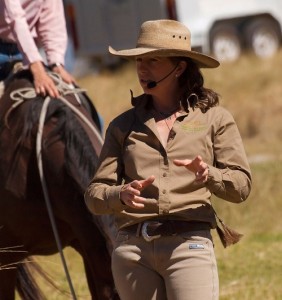 Figure 3 I like this picture of myself taken during a course I was teaching. I must have been feeling very centred at the time. I can see it in my body posture. Shoulders are completely relaxed, and my centre of gravity is down low, my centre is even positioned forward in my posture. I was probably explaining about how to get your horse to go using energy from your centre. My hands are down in the area of my centre – everything is coming from my centre. There is a feeling of confidence, certainty and leadership and yet softness in this body posture.
Figure 3 I like this picture of myself taken during a course I was teaching. I must have been feeling very centred at the time. I can see it in my body posture. Shoulders are completely relaxed, and my centre of gravity is down low, my centre is even positioned forward in my posture. I was probably explaining about how to get your horse to go using energy from your centre. My hands are down in the area of my centre – everything is coming from my centre. There is a feeling of confidence, certainty and leadership and yet softness in this body posture.
When we are centred we become emotionally neutral rather than emotionally volatile, which means that we respond rather than react. When we can respond without an attachment of negatively charged emotion we can always find the solutions to problems sooner and the outcome is always better. When dealing with horses or people for that matter, if we have an attachment of negatively charged emotion behind our actions or communications it brings up emotion, reactiveness or defensiveness in them. It is very instinctive for people to react to the emotions in others.
When we are dealing with a horse that is fearful, anxious, angry or resentful and we react to it with underlying negative emotion because it brings up frustration, anger or fear in us, this amplifies the emotion in the horse causing them to become even more defensive, resistant, reactive or uncooperative. However in that same situation if the horse was to feel in us the qualities of being centred, like stillness, calmness, certainty, softness and neutrality which means non-judgement, then this state of being would start to diffuse and dissolve the horses negative emotions. When we are centred we are radiating a very positive, stable and calming energy into our energy fields which then filters out and affects all around us in a positive way. This embodies good leadership.
 Figure 4. Here Arumi, my new stallion, is testing my centredness. He has his ears pinned back and was just about to lunge at me quite aggressively because he got confused and felt challenged when I was asking him to canter on line. I just stayed in my centre and redirected his energy and intention with my focus and stick and string. Below you can see him literally just moments later, very happy and in very good posture because he is in a good mental and emotional place as he took no offence to my correction.
Figure 4. Here Arumi, my new stallion, is testing my centredness. He has his ears pinned back and was just about to lunge at me quite aggressively because he got confused and felt challenged when I was asking him to canter on line. I just stayed in my centre and redirected his energy and intention with my focus and stick and string. Below you can see him literally just moments later, very happy and in very good posture because he is in a good mental and emotional place as he took no offence to my correction.
Sometimes it may seem that when we respond with anger it resolves the situation because the other party backs down or changes their behaviour, because they decide that is their best option in that moment, but usually that emotion is just supressed, held on to and will fester and come out at another time and usually at a very undesirable time, when under pressure or in a crisis.
SELF MASTERY – The ability not to react to the reactions of others. – Mel Fleming
One of the hardest things in the world to do is to have no reaction to the reactions of others or to stay centred when all those around you are out of their centre. I think this equals self-mastery, the ability not to react to the reactions of others and to stay in your centre when all those around you are losing theirs. This ability exemplifies real leadership, the ability to keep your calm and your cool no matter what.
As soon as we allow negative emotion to come up and take over we are demonstrating a clear lack of leadership and proving to the horse that we are not a trustworthy leader that they can depend on to keep them safe and make good judgements and decisions. As soon as negative emotion comes up and takes over, we can feel it in our body as tightness and tension or as heat and our breathing shallows or stops. As we energetically become more aware, we will notice that energetically we have moved up out of our centre. You can literally feel yourself rise out of your centre and as the saying goes “they got a rise out of you”.
This physical tension, resistance and restriction that results from us being out of our centre also prevents us from physically offering a soft smooth feel to the horse and stops us from being free in our bodies and thus able to move in balance and harmony with the horse while riding. This physical resistance or brace in us, which always begins in our minds, results in resistance and brace in the horse. We are the ones that create brace in the horse.
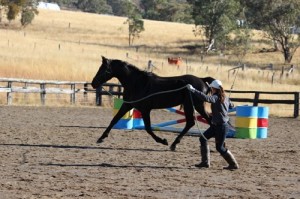 Figure 5. Here is Arumi, just moments later after he threatened to run at me. He is perfectly happy and see what great lift and suspension he has now. He is really starting to push off his hind legs because he became mentally and emotionally centred, therefore he physically became more centred and balanced.
Figure 5. Here is Arumi, just moments later after he threatened to run at me. He is perfectly happy and see what great lift and suspension he has now. He is really starting to push off his hind legs because he became mentally and emotionally centred, therefore he physically became more centred and balanced.
Being centred is not about never feeling emotion and it is definitely not about supressing it or pretending it is not there when we feel it. In fact it is quite the opposite. It means being more aware sooner when emotion comes up, recognizing it, acknowledging it, accepting it and in that way we can make a choice, asking questions about it and changing things that need to change if necessary and then let the emotion go, which is very different than suppressing it. Feeling emotions is good, they are not a bad thing, they are just feedback, giving us information about what is going on inside us. So it is about learning how to work with emotions and using them for their purpose of gathering information and then releasing them rather them have then start taking control of us.
Being centred is also a very physical thing, it causes us to be more physically balanced. When our mind is scattered and our emotions are awry, then our energy is trapped up high in body, for example in the head, throat and chest areas rather than being balanced throughout the body. These areas then become physically tight and tense and this can often be clearly visible through locked jaws, tight throats, high raised up shoulders, and stiff upper bodies and chests. This causes us to become very unbalanced.
If you observe a new rider on a horse that is very unconfident on a horse and somewhat fearful, you will most likely see the tight raised up shoulders and their hands holding the reins up high, putting them in a very unbalanced and vulnerable position. To be balanced, we need our body weight, you can think of this as all your muscles, to be relaxed and melting down into our centre. This brings you into balance rather than being top heavy and out of alignment. This downward feeling is counterbalanced by the skeleton and more specifically the spine, being lengthened upward, so that the spine is long, tall, aligned and stretching to open the spaces in between the vertebrae. This prevents our downward bodyweight, that of the muscles melting down, being a hindrance or a block for the horse to move his back and body freely underneath us. It puts us in our own self carriage and when we are in self carriage then our horses can be.
Figure 6 This photo shows a good position and balance over a jump. Keeping my centre back over the horse rather than too far forward over the pommel of the saddle which would be putting too much weight on the horse’s front end and impede the horse.
When we are centred with a still mind, we are able to give clearer communication and cues to the horse and our thoughts become so clear that horses can start to pick up on them. When we still the mind and calm the emotions we can actually focus our attention and we can learn quickly and easily.
When we are still and centred our awareness and perceptiveness of ourselves internally and how we are feeling our own body is greatly heightened. Even better, is that as well as having heightened internal awareness, at the same time we can have a heightened external awareness, being aware of all that is going on outside around us. When we are riding horses, we need to be able to feel and have a great awareness not only of our own bodies, but also our horses bodies and also be aware of all else around us, other people, horses, stock if we are working or moving stock, and or have awareness and focus of the line we are on if we are cantering cross country and negotiating obstacles or riding a showjumping course for example. Riding horses well requires having a very heightened awareness. Better body awareness leads to better body control and coordination and balance. Therefore improving our body awareness is a major key to physically improving our riding and horse handling skills.
We need to get into the zone of feeling more than thinking. This means getting out of your head which is more about thinking and down into your body which is more about feeling and it is through being centred that people can develop that ever elusive and yet such important quality of FEEL, which then also gives them timing and balance. ‘Feel’ is the difference between a true horseman and all the other horse people. Feel is in two categories, physical feel and energetic feel which also includes mental and emotional feel. Centring is the key to developing ‘feel’.
HOW do we get centred?
CENTRING
To centre yourself first of all just take your attention down to the physical area of you centre, the lower abdominal area and heading down towards the pelvis. Just taking your attention down there starts to take your energy there. Relax all of your muscles and allow any tension in the upper body to melt down into your centre.
BREATHING
Breathing down into your centre is the next step to getting centred. When we breathe we should expand our belly on the in breath. Most people tend to do the opposite. That is they contract their stomach or draw it in, on the in breath as they are using shallow chest breathing rather than breathing fully and efficiently with abdominal breathing. Shallow chest breathing is a result of states of stress and causes people to stay in a state of stress. Deep abdominal breathing, where we expand the belly on the in breath stimulates the parasympathetic nervous system which calms everything down and induces relaxation. Even more that just thinking of expanding the belly forward, I like to think of expanding all of the centre in all directions equally, expanding it to the front, back and sides equally. Deep and full abdominal breathing stimulates the right hemisphere of the brain, our relaxing, imagining, feeling, intuitive and movement side of brain.
Other benefits of this centred and full breathing are that when we think of expanding our centre in all directions equally it stabilizes our core which leads to better balance. When riding we need to find a way to stabilise our core that does not involve a tightening, contracting and holding pattern in the muscles. Breathing and expanding the centre and then fully inflating all of the lungs and thus expanding the entire torso puts our body in alignment and thus into balance. Balance comes from correct biomechanical alignment of the body which means that all the muscle tension patterns in the body have to be optimal and counterbalancing each other so that standing, moving, sitting for example feel effortless. When we are holding excess muscle tension patterns in certain parts of the body due to states of mental and emotional stress our skeleton is pulled out of alignment and thus we have compromised balance. Centred breathing relaxes our body and releases these excess muscle tension patterns.
BODY SCANNING
The third thing that I think about is body scanning. I continuously have awareness of my body and scan my body for any tension. Any physical tension that I feel in my body tells me that I am not fully relaxed and not fully centred. For a quick check list I check the following:-
Breathing – Are you breathing ? And if so, are you breathing down into your centre?
Jaw – Are your molar teeth touching at the back? That is usually a sign of a clenched jaw.
Fingers – Are they clenched or holding the stick, reins or lead rope tighter than necessary?
Toes – Are the scrunched up in your boots or softly spread open?
Buttocks and tail bone – Are your buttocks clenched or soft and relaxed? Is your coccyx, your tail inside your skin, swinging gently from side to side when you walk?
Figure 7 Alchemist and I. Alchemist is showing very good balance and posture here. Well on the way to collection.
I also scan my horse’s body for tension. When I see any signs of tension in my horse’s body that is my cue or reminder to centre and breathe, or to centre and breathe more deeply and if I notice tension in a specific part of my horse’s body, for example the horses jaw, then I also relax my jaw and the horse will then mirror this.
Figure 8 This image shows the rider’s centre and the horse’s centre. When we are riding, in our minds we mentally want to think about connecting our centre to our horses centre.
Horses need be in their centre too, but this will be a whole other article at some stage. For now we will suffice to say that just as centring is a mental, emotional, physical and even spiritual place to be for the human it is the same for the horse. A horse that is not centred is on their forehand and a horse that is centred will be in some degree of self carriage, engagement or collection. The horse’s centre is the same as for us the lower abdominal area, flank area and going back into the pelvis. Again please note that the centre as we are talking about it here, is different to the horse’s physical centre of mass which also an important point which we can expand into at another time. As the horse becomes more “centred” in the sense that we are talking about it, their physical centre of mass shifts further back which is what physical collection is about. When we are centred we lead our horse into being centred.
So hopefully through reading this article you can see the absolute importance of being centred, it affects everything.



